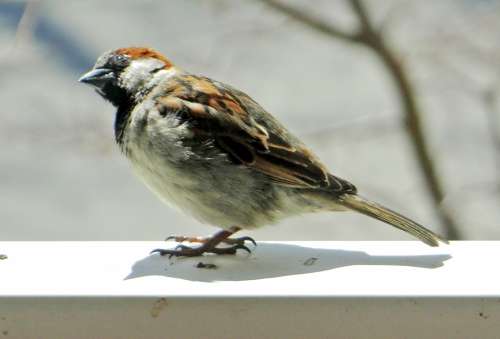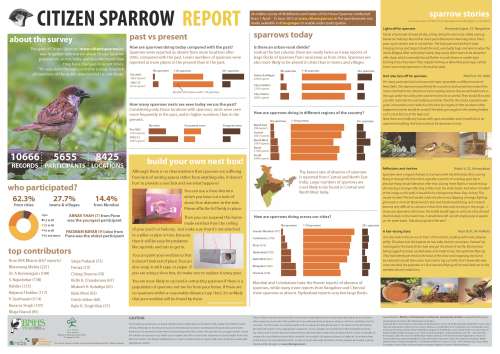One of the famous quotations from “Hamlet” by William Shakespeare is “There is Providence in the fall of a sparrow.” The import of which is that God has a hand in everything that goes on, even the death of a pretty little bird. No matter how small or insignificant something seems, God cares about it and has control over it.
But in recent times, one has had occasion to muse on the fall of the sparrows, or, to be specific, of the House Sparrow, whether or not there is Providence in it.

House Sparrow male. Pic: Deepa Mohan
The House Sparrow (scientific name, Passer domesticus) is so named because it has always been associated with human habitation. The Wiki entry for the bird says, “it occurs naturally in most of Europe, the Mediterranean region, and much of Asia. Its intentional or accidentalintroductions to many regions, including parts of Australia, Africa, and the Americas, make it the most widely distributed wild bird.” The IUCN (International Union for Conservation of Nature) list has the bird’s conservation status at “least concern”. However, the scenario in India belies this rating.
![]()
In the fifties and sixties, urban Indians grew up in a world where these perky birds were abundant in the cities. I remember that my mother used to put out rice and grains along the edge of our apartment balcony; it had railings that prevented bigger birds from coming in, and a House Sparrow mother, who’d built her nest in the ventilator of our neighbour’s home, would come regularly to peck at the grains and regurgitate them to her nestlings. She often brought along the refuse-sac of the nestlings, and my mother would joke that she was getting paid for setting out the rice!
From this comfortable scene, to today....the House Sparrow’s populations in India seem to be in decline. From being a very commonly seen bird a few decades ago, amateur bird watchers as well as learned ornithologists have found the species getting rarer, and various theories have been advanced to explain this decline in the House Sparrow numbers.
One theory, of course, was the loss of habitat for the birds. Older houses had ventilators, lofts, holes between the walls, spaces in the eaves of the roof, and between roof tiles, for these little birds to nest and breed, free from disturbance. The winnowing of grain resulted in the free availability of food for the birds, from the grains, as well as from various small insects found along with them. With the changing of urban lifestyles, lower ceilings and apartments meant no nooks and corners for the birds to nest.
Video shot by Deepa Mohan
Non-availability of plentiful grain, with the old custom of winnowing grain in the open courtyards of houses disappearing with the new styles of architecture, and the decrease of such food processing in people’s homes also contributed to their gradual fall in numbers...
Another theory advanced to explain their decline was that of predatory attacks by the Eurasian Sparrowhawk, a raptor that often swoops down on unwary sparrows and kills and eats them. The construction of mobile phone towers, as also the electromagnetic radiation from mobile phones, was also thought to be a factor in the decline in the bird’s numbers in both rural and urban areas in India. Disease, too, has been cited as a factor, even though it has generally been held that the House Sparrow is a robust, hardy bird.
Tracking the fall
How is the fate of the House Sparrow being tracked? There are, of course, the expert ornithologists’ observations and reports, in journals such as Indian Birds and also the website ofCommon Bird Monitoring of India (CBMI), a Citizen Science Programme of Nature Forever Society. Many organisations and individuals are part of the programme. The aim of the programme is to collect data on common Indian birds. It is a pioneer project, certainly a first of its kind in the country to monitor the common birds, and it depends on the participation of as many laypersons and interested birdwatchers to be successful. CBMI includes the House Sparrow in its list of common birds.
Though not as long-standing a monitoring exercise as that of CBMI, a recent survey done between April and July, 2012, by Citizen Sparrow has been an intense exercise in monitoring the species, with 10,666 records, from 5655 pariticipants across 8425 locations in India. This was a big initiative involving every citizen possible; the oldest participant was 91, and the youngest, 7. The findings do indicate a fall in the numbers of House Sparrows. Data continues to come in, and is still being logged.
Summary of findings of Citizen Sparrow Survey
- There has been a definite decline in House Sparrow numbers.
- The absence of Sparrows is the least in Central and North-east India.
- Sparrows are likely to be found in large numbers, in Central and North-west India.
- Sparrow nests were seen more frequently in the past, as compared to now.
- 62.3% of respondents were from cities, and 27.7% were from towns and villages.
- Setting up of nest-boxes and providing food and grain will form part of the key to increasing sparrow numbers.
![]()

Citizen Sparrow poster, giving details of the survey and its findings. (click to enlarge)
A world without sparrows?
However, there is a lesser-liked side to the House Sparrow, too. It’s commonly regarded as a pest, since it consumes agricultural products and spreads disease to humans and their domestic animals. Even birdwatchers sometimes hold it in little regard because of its molestation of other birds; it is a very aggressive bird. In most of the world, the House Sparrow is not protected by law.
Attempts to control House Sparrows include the trapping, poisoning, or shooting of adults; the destruction of their nests and eggs; or less directly, blocking nest holes and scaring off sparrows with noise, glue, or porcupine wire. However, attempts at the large-scale control of the House Sparrow have failed. The most notorious campaign against sparrows was in China, where under the perceived notion that Eurasian Tree Sparrows were eating too much grain, hundreds of millions of sparrows were killed in 1958. By 1960, the catastrophe happened...without the sparrows to keep it in check, the insect population exploded, and this contributed to the Great Chinese Famine between 1958 and 1961, where three million people died of starvation due to lack of foodgrain, especially rice. I have personally seen a sign in the city of St.Louis, asking everyone to kill House Sparrows, and destroy their nests, as they are an “invasive species”.
Karthik K, who spearheaded the Citizen Sparrow survey, making it part of his Master’s degree thesis, responds to questions regarding the House Sparrow.
1. If you feel that there has been a serious fall in the number of House Sparrows (in the past or even to date), what are the factors you would ascribe to such a decline?
The Citizen Sparrow results suggest a clear trend of decline in House sparrows in India. House sparrows as the name suggests have evolved along with the humans. The basic requirements for House sparrows (or any bird) are food and nesting place. The House sparrow chicks/nestlings require insects for their diet. Any use of pesticides would result in less insect availability for House sparrow nestlings. House sparrows nests are found in wall crevasses/ small holes etc in people's houses. Lack of suitable nesting space near human habitations can also cause a decline in House sparrows. In the current scenario, it appears as if there is a problem in both food and nest requirements of House Sparrows.
3. How much weightage would you give to the "mobile towers" theory, given that sparrows are still found in areas like K R Market or Russell Market, at the heart of a city like Bangalore?
KR Market and Russell Market are some of the oldest markets of Bangalore. There are a lot of vegetable, fruit, flower, and provision shops in these markets. Naturally, there are a lot of dumping yards of bio-waste in these areas. As a result, there is availability of insects, which is very important for House sparrow nestlings. I have also keenly observed the presence of old buildings in these areas which have breaks/ holes in the walls of these buildings where there are active House sparrow nests. As the nesting space and food resources are available in these old markets, House sparrows are found in good numbers in these areas.
There are a few studies in the European countries which have tried to evaluate the effect of Mobile Towers on House Sparrow population. But the results are not convincing enough to jump to conclusions that Mobile Towers are responsible for House Sparrow decline. In India, there is no scientific proof to believe that Mobile Towers are a factor in the decline of House Sparrows.
4. What steps would each of you suggest to further augment the House Sparrow population, whether rural or urban?
It is necessary to provide good food and nesting habitat for House Sparrows. There have been good initiatives all over the country to provide nest boxes for House sparrows to improve the nesting space for House Sparrows. Initiatives like these need to continue, but more attention should be given to avoid pesticide usage both in urban and rural areas.
5. Is there any special insight that you would like to add?
As I have already mentioned, there have been House Sparrow nest box campaigns and thousands of nest boxes have been distributed. Conservation efforts should not end by just providing nest boxes, but importance should be given to evaluate the effectiveness of such nest-boxes so that we can get better insights about House Sparrows.
![]()
To many people across the world, however, the House Sparrow is the most familiar wild bird, and because of its association with humans and familiarity, it is quite popular. But for most of us, the value of the House Sparrow is only apparent when its numbers start falling, and we are no longer able to see the feisty, perky little birds that hop around so cheerfully around human habitation.
Let’s hope that this little bird, which has been immortalized in song and verse in many cultures, holds its own in our country in the years to come.
























